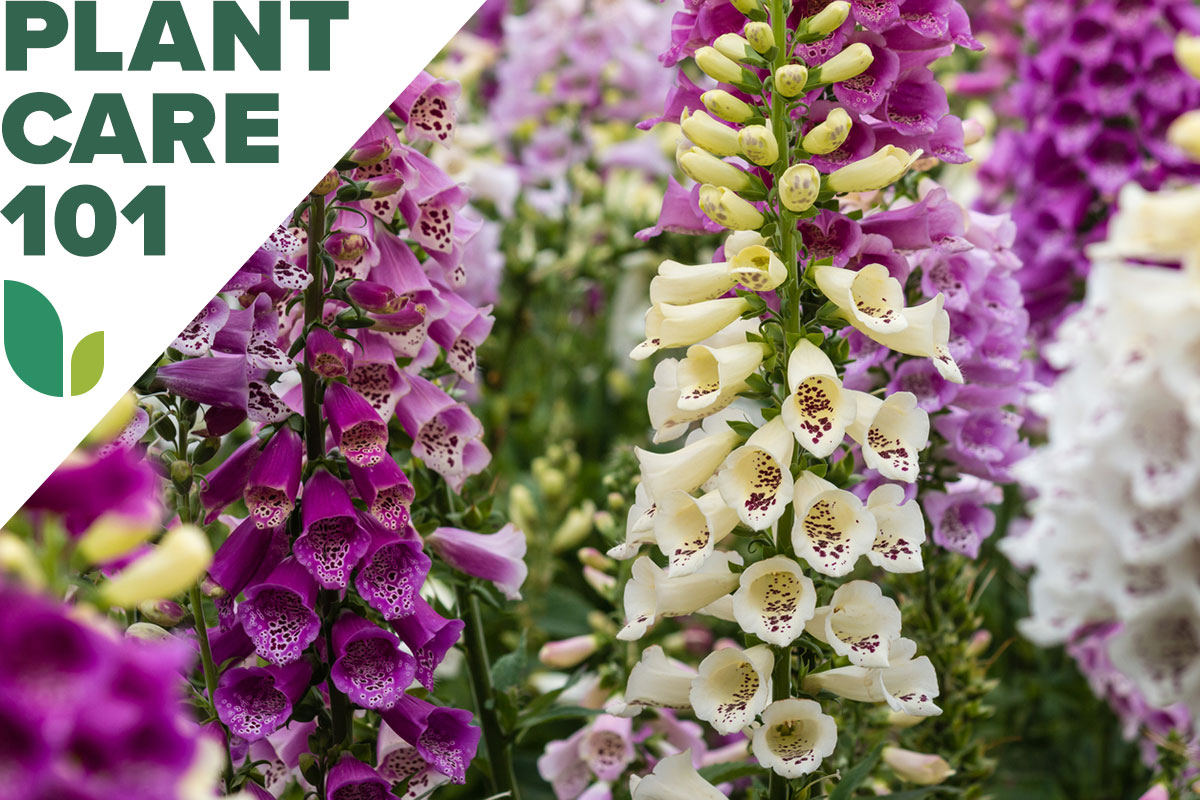

We may earn revenue from the products available on this page and participate in affiliate programs. Learn More ›
Stately foxglove hails from 15th century Europe, when the Anglo-Saxons named it “digitus,” Latin for finger-like, and began using it for medicinal purposes. The name relates to the size and shape of the flowers, which could slip onto a finger like a glove. Also called witches’ glove, Digitalis consists of 20 species featuring the signature brightly colored tubular, bell-shaped blooms with spotted throats lining tall, narrow stalks.
A favorite of pollinators, foxglove is one of the rabbit- and deer-proof plants, due to its toxicity to humans and animals in affecting the heart rate. In Zones 4 through 10, foxglove care is simple.
RELATED: 9 Reasons Why Fall Is for Planting
Growing Foxglove at a Glance
Common Name: Foxglove
Scientific Name: Digitalis spp.
Hardiness Zone: 3 to 9
Soil: Rich, well-draining; pH less than 6.0
Light: Full to partial sun
Water: Keep soil moist, but not waterlogged
Food: Mulch is enough, but can use slow-release 5-10-5 fertilizer in spring
Propagation: Seed
Safety: Toxic to animals and people
Foxglove Characteristics
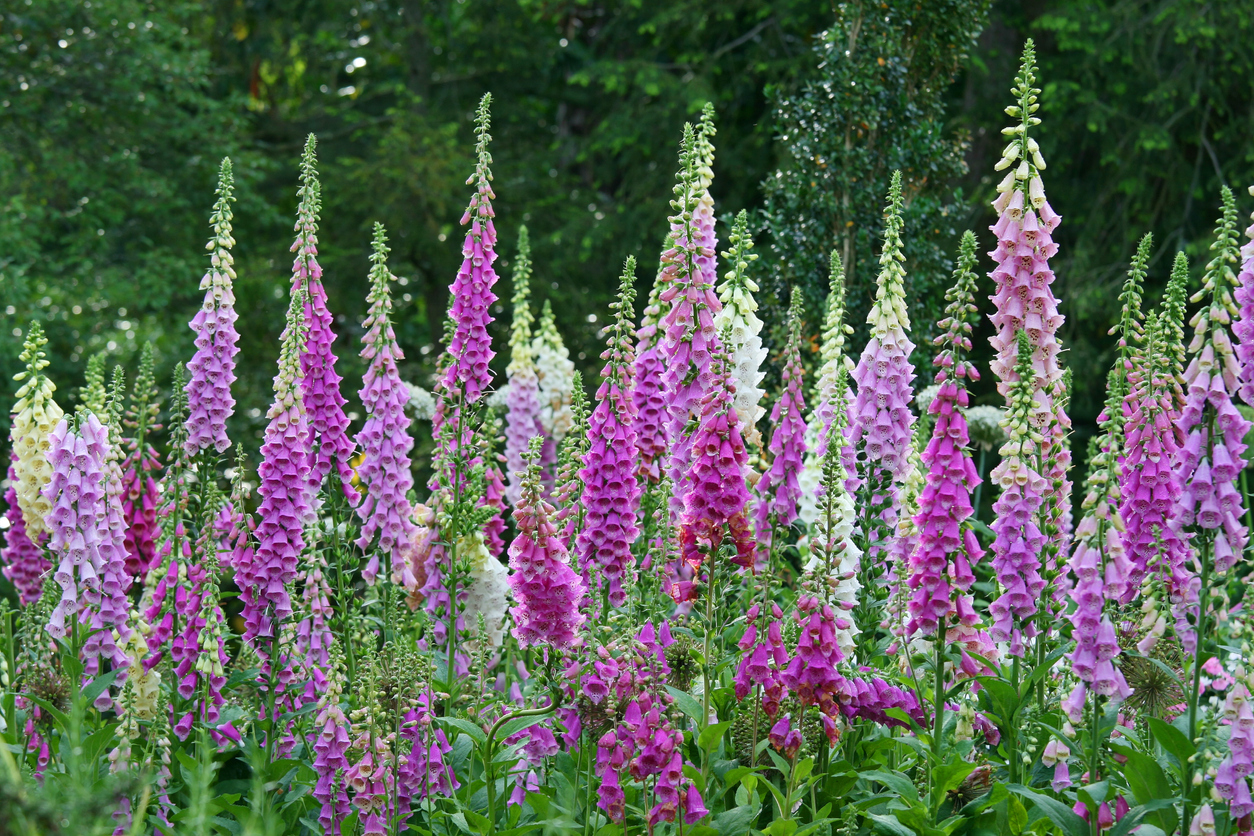
Grown in cottage gardens since the Middle Ages, foxglove is a beautiful, but potentially deadly, flower. All you’ll see from the biennial foxglove plant in its first year is a “ground-hugging rosette of green leaves,” says Jo Ellen Meyers Sharp, The Hoosier Gardener, garden writer, speaker, and coach. She says the wait until year two is well worth it, however. A fast-growing biennial, foxglove can produce 3- to 5-foot spires of bell-shaped flowers in its second year. It often reseeds itself, making it appear to be a perennial.
Flower stalks can be covered in 20 to 80 downward-facing flowers, each of which features a small “lip” that acts as a landing pad for bumblebees seeking nectar. Foxglove colors include pink, purple, and white. Blooming from late spring through mid-summer, the foxglove flower is a favorite of hummingbirds and other pollinators, as well.
Beware that foxglove leaves, stems, flowers, and seeds are poisonous to people and pets, as they contain digitalis and other cardiac glycosides that affect the heart.
Recommended Foxglove Varieties
There are several varieties of foxglove. While Digitalis purpurea is the name of the common biennial, other varieties have much to offer, including different blooming patterns.
- D. purpurea ‘Camelot Lavender’: The most popular of foxglove hybrids due in part to its ability to flower in its first year, Camelot comes in many colors, but this striking lavender has 2- to 3-inch flowers with maroon-speckled throats.
- D. purpurea f. albiflora: First cultivated in 1737, Alba is a stunning white foxglove featuring 2- to 3-inch creamy white flowers that highlight purple-speckled throats for a dramatic look.
- D. hybrida ‘Arctic Fox Rose’: A shorter (18- to 24-inch) foxglove with 2-inch soft pink flowers that have peachy speckled throats, Arctic Fox blooms from April to September in Zones 5 to 9.
- D. purpurea ‘Candy Mountain’: If you prefer that foxglove flowers look up instead of down, this soft pink variety with maroon-speckled throats will dazzle at a height of 4 feet in Zones 4 to 9.
- D. grandiflora, or Yellow Foxglove: Diverging from the typical white-pink-purple color palette, yellow foxglove features pale yellow flowers with brown-spotted throats on 3-foot spikes and is hardy in Zones 3 to 8.
- D. purpurea Excelsior hybrids: Another popular hybrid, this variety comes in mixed colors of light pink, purplish-pink, and peach, and its flowers grow horizontally to showcase their speckled throats in Zones 4 through 8.
Planting Foxgloves

Because foxglove is a biennial, it is often purchased as a nursery plant to get a head-start on blooming, but foxglove seeds can also be planted.
When is the best time to plant foxglove?
The best time to plant foxglove is in late summer or early fall. This gives the plant time to establish a root system before cold weather starts. Seeds and bedding plants can also be planted in early summer to take advantage of warm temperatures. If sowing seeds indoors, start them about 10 weeks before the last frost.
Where can foxglove grow?
Growing foxgloves requires full sun to light shade, Meyers Sharp says—depending on how hot the summers get. Often found along roadside verges or woodland edges in USDA Zones 3 to 10, foxglove appreciates well-draining, slightly acidic soil. “Although it prefers organically rich, moist soil with good drainage, it pretty much tolerates about any soil, including clay,” says Meyers Sharp.
When planted in garden beds, foxglove usually goes toward the back, due to its height. It also can be used as a tall border or a sort of hedgerow.
How do you plant foxglove?
If planting foxglove seedlings in the late spring or fall, space them 1 to 2 feet apart:
- Dig the hole twice as wide as the starter pot’s diameter.
- Place the top of the root ball even with the surface of the soil.
- Backfill, tamp down the soil, and water.
- If planting more than one, space them 1 to 2 feet apart.
If starting foxglove from seed:
- Sow in a prepared garden bed. Do not cover with dirt.
- Keep warm and moist for 3 weeks until germination.
- Thin seedlings to 18 inches apart.
Can you grow foxglove in containers?
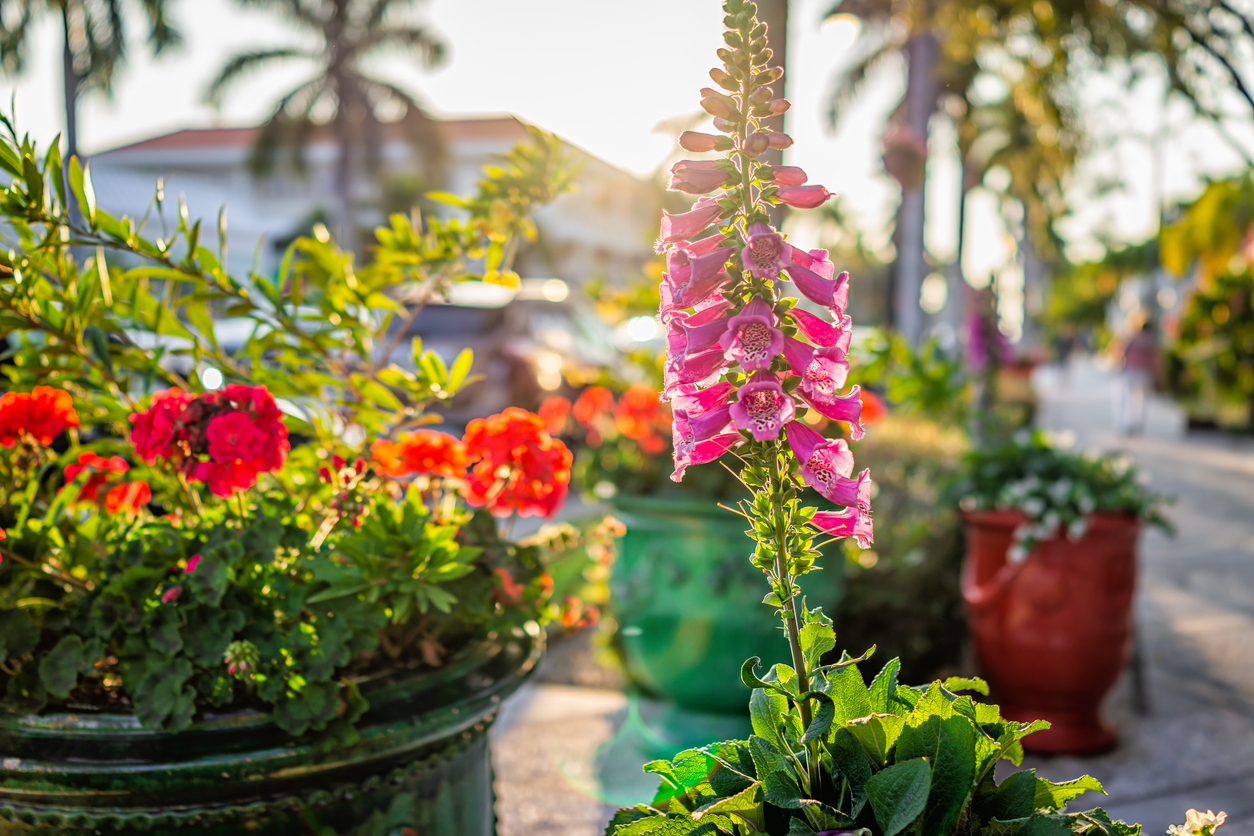
Foxglove can be planted in containers—large containers capable of providing enough space and heavy enough that they won’t tip over. Second-year plants benefit from some type of support so they don’t fall over. Some of the shorter foxglove varieties might work better in containers. “For some height in a container of pansies, Johnny jump-ups, primroses, and other spring flowers, plant foxgloves as a centerpiece in the mix,” Meyers Sharp says.
Use rich, well-draining soil and keep it moist, but not water-logged. Foxglove flower care depends on the amount of heat your region experiences. Place the container in partial sun or shade where summers are hot.
When foxglove blooms, if you let the seeds fall into the container, they will self-propagate for future plants—or, you can collect the seeds to start new plants elsewhere.
RELATED: How to Use Coffee Grounds in the Garden
Watering Foxgloves

Foxglove likes evenly moist soil, but because this plant is susceptible to crown rot, it shouldn’t be overwatered. Acidic soil and good drainage are critical for foxglove.
Foxglove will need watering during summer drought periods, particularly when in bloom. If the soil feels dry in the top 2 inches, the plant needs water—but should not be watered from overhead, which can encourage fungal disease. Drip irrigation provides a steady source of water to the roots.
Fertilizing Foxgloves
In rich, organic soil, foxglove doesn’t typically require any fertilizer beyond a 1-inch layer of decomposed mulch. In fact, too much nitrogen can inhibit flower growth.
In poor soil, adding slow-release 5-10-5 granular fertilizer in the early spring can boost plant growth and increase the size and number of blooms. Follow instructions on the package for application. Fertilizer should be watered in, taking care that it doesn’t touch the leaves because it can burn the plant.
Safety Considerations
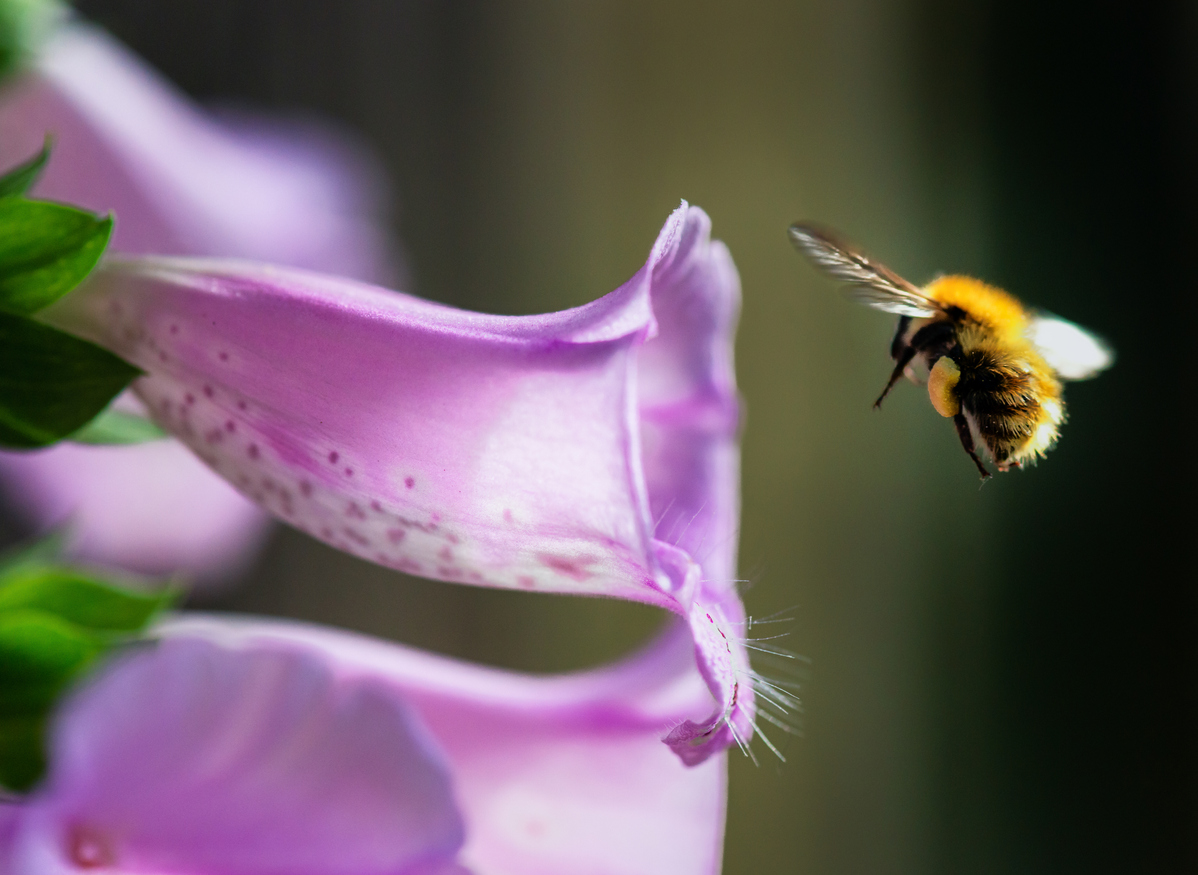
All parts of foxglove are toxic to people and animals, although birds, butterflies, bees, and other insects can safely feed on the nectar. While reported poisonings are rare, every part of the plant contains digitalis and other cardiac glycosides used to make heart medication, so ingesting any part of the plant can be toxic or even deadly.
Vincent Van Gogh might have self-medicated with digitalis to treat his epilepsy. His “yellow period” is thought to have resulted as a side effect, because it can create a yellow haze in a person’s vision.
RELATED: 14 Old-Fashioned Flowers That Still Look Great in Today’s Home Gardens
Potential Pests and Diseases
“Foxgloves don’t have a lot of insect problems, except an occasional aphid infestation,” Meyers Sharp says. However, powdery mildew can be a common problem, although she says it’s more aesthetic than deadly. To prevent them, “Allow for good air circulation when planting,” Meyers Sharp advises. Also, ensure that their soil drains well.
Other potential insect problems can come from mealybugs, slugs, and Japanese beetles. Mild cases might be taken care of by predatory insects; treat heavy infestations with insecticidal soap.
Preparing Foxglove for Winter
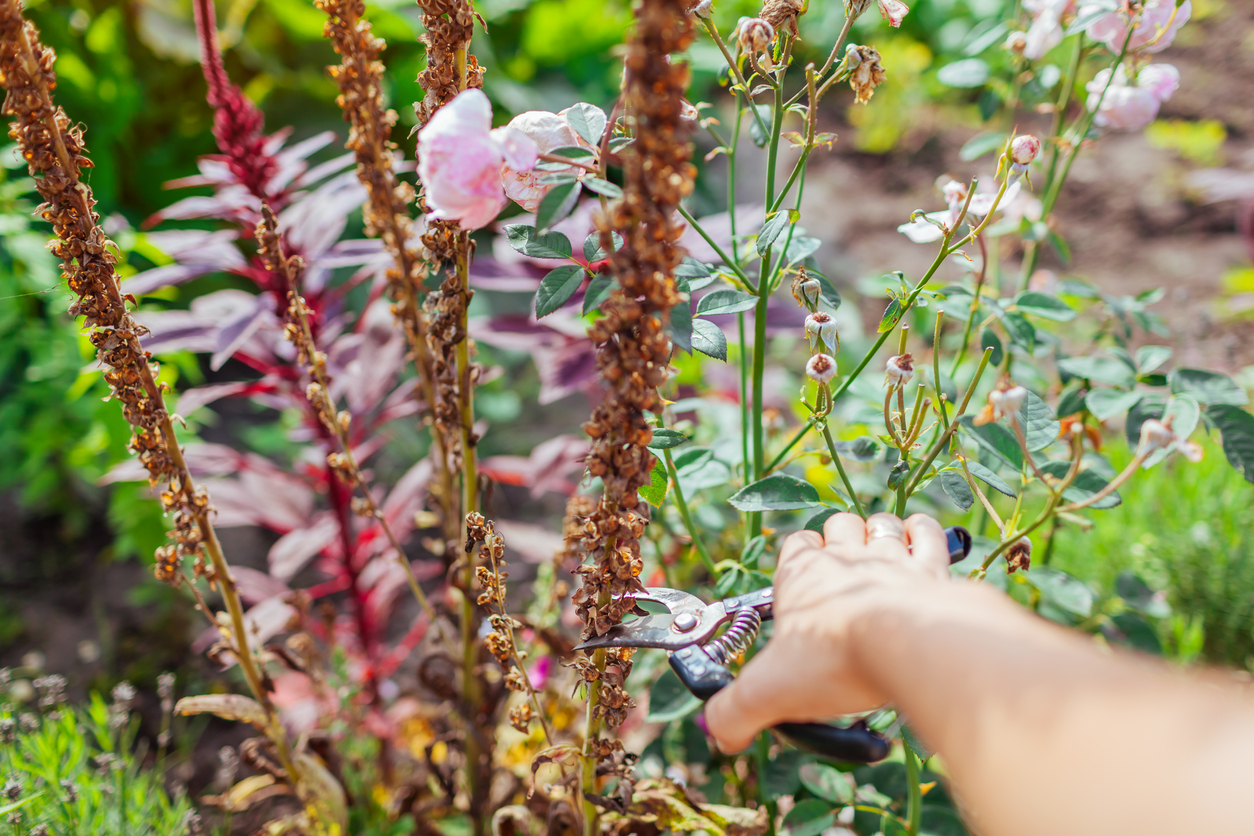
If your foxglove plants bloomed in the summer, cut the plant back to just above the rosette or pull up the entire plant and throw it away before winter arrives. They won’t bloom again, so it’s best to remove the dead plants. Allow time for some or all of the spent flowers to self-seed if you want new plants in the spring.
Cover first-year plants with mulch or a thick layer of dried leaves after the ground freezes. This will protect them until spring, at which time you should remove the mulch and leaves to prevent crown rot.
Looking for more flowering biennials? Check out our guides on growing late-blooming flowers and saving seeds.
